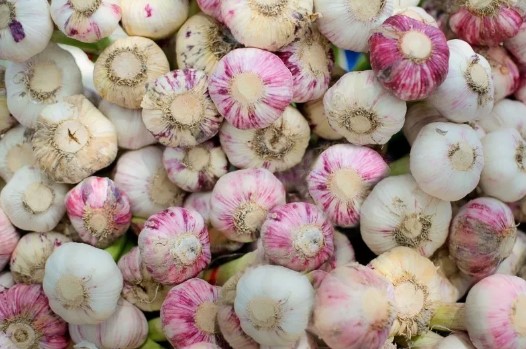CHOOSING YOUR GARLIC FAVORITES

How do you choose which varieties of garlic to purchase? There are so many options…it can be a hard decision. Maybe this little tool will help you pick and place your order. All garlic seed for sale is supplied by our small micro-farm in Elgin Oregon – Greif’s Gourmet Garlic!
Below, we have listed some of the characteristics people look for in garlic. Based upon our experience and online documentation about garlic varieties, we’ve tried to classify garlic varieties’ traits to fit these characteristics that people like in their garlic.
Please keep in mind that most garlic varieties are good for most common garlic uses! So if a garlic variety does not appear as being strong in a category, it might be that it is just slightly “not quite as perfect” for that use, but would still be wonderful if utilized for that particular purpose.
Hopefully, this tool will help you. To use it, simply follow these steps:
- Scan through the characteristics below (green-colored text).
Pick the ONE that you think is the most important to you.
Click that important characteristic (it is a link). - This will take you to a list of garlic varieties that we feel best to meet this characteristic’s description.
Write down the names you see under the appropriate heading. - Choose the SECOND-most important characteristic to you, and click it. Write down those garlic varieties.
- If any of the answers from your first and second results match, then that variety might be an excellent one for you.
- Keep going through additional characteristics in the order of importance to you if you feel a few more traits are urgent. The more times you see a certain garlic variety’s name, the more likely that it could be an excellent one for you!
GARLIC CHARACTERISTICS
Quicker summary-like steps to follow (same as above, but condensed):
Step 1: Look through these characteristics, below. Pick the most important one, and click it.
Step 2: Write down the names of those garlic varieties that are known for matching that characteristic.
Step 3: Choose another important characteristic from the list below, and click it.
Step 4: Jot down names, and compare to your list from the first group. If any matches are found, circle them…they might be perfect for you! Continue on if you are interested in more traits.
(Note that a bulb is the whole “head” of garlic, while a clove is one piece off the garlic bulb)
| Large-sized individual cloves | Excellent for roasting | Easy-to-peel |
| Many cloves per bulb | Strong garlic flavor | Longer storage life |
| Potentially huge bulbs | Medium heat/flavor | Makes the best scapes |
| Good raw (such as on salads) | Mild garlic flavor | Good for garlic braiding |
| Popular for cooking | High Allicin Content |

Large-sized individual cloves
Hardneck(s): German Red, Siberian, Metechi, Spanish Roja, Music, Georgian Crystal, Brown Tempest, German Extra Hardy, Killarney Red, Zemo, German White
Softneck(s): Polish White, Inchelium Red, Kettle River Giant, Siciliano

Back to Characteristics
Many cloves per bulb
Hardneck(s): Hardnecks typically have 9 or less cloves per bulb
Softneck(s): Silver Rose, Inchelium Red, Kettle River Giant, Transylvanian

Back to Characteristics
Easy-to-peel
Chesnok Red, Italian Purple, Stull, Spanish Roja, Killarney Red, Music

Back to Characteristics
Longer storage life
Hardneck(s): Brown Tempest, Georgian Crystal
Softneck(s): Silver Rose (excellent), Inchelium Red, Kettle River Giant, Siciliano, Transylvanian

Back to Characteristics
Excellent for roasting
All varieties taste good roasted, but our favorites might include:
Hardneck(s): Metechi, Siberian, German Red, Spanish Roja, Music, Zemo, Killarney Red
Softneck(s): Polish White, Inchelium Red, Kettle River Giant, Siciliano
Also, Elephant.

Back to Characteristics
Potentially huge bulbs
Hardneck(s): German Red, Siberian, Italian Purple, Metechi, Spanish Roja, Music, Killarney Red, German White, German Extra Hardy
Softneck(s): Polish White, Inchelium Red, Kettle River Giant, Siciliano
Also, Elephant.

Back to Characteristics
Strong garlic flavor
Hardneck(s): German Red, Siberian, Metechi, Stull, Romanian Red, Red Rezan, Zemo
Softneck(s): Lorz (strong but low heat), Transylvanian

Back to Characteristics
Medium heat/flavor
Hardneck(s): Italian Purple, Persian Star, Spanish Roja, Chesnok Red, German Extra Hardy
Softneck(s): Inchelium Red, Kettle River Giant, Silver Rose, Siciliano

Back to Characteristics
Mild garlic flavor
Hardneck(s): Georgian Crystal, Spanish Roja (fading heat), Killarney Red
Softneck(s): Polish White (fresh), Inchelium Red (fresh), Susanville
Also, Elephant.

Back to Characteristics
Good raw (such as on salads)
Hardneck(s): Georgian Crystal, Spanish Roja, Killarney Red
Softneck(s): Polish White, Inchelium Red

Back to Characteristics
Great for cooking
All, but favorites might include:
Hardneck(s): German Red, Chesnok Red, Italian Purple, Music, Spanish Roja, Zemo
Softneck(s): Siciliano, Inchelium Red, Polish White, Kettle River Giant, Susanville
Also, Elephant.

Back to Characteristics
Makes the best scapes
Hardneck(s): Music is our favorite, followed by German Red, Fireball, and Spanish Roja. However, all hardnecks make a scape.

Back to Characteristics
Good for garlic braiding
Softneck(s): All (favorites include Silver Rose, Polish White, Siciliano, Inchelium Red).
Consider buying the “average size” garlic, as a huge stalk may not be as pliable.

Back to Characteristics
High Allicin Content
All garlic, with higher content possibly in Zemo, Georgian Crystal

Back to Characteristics










